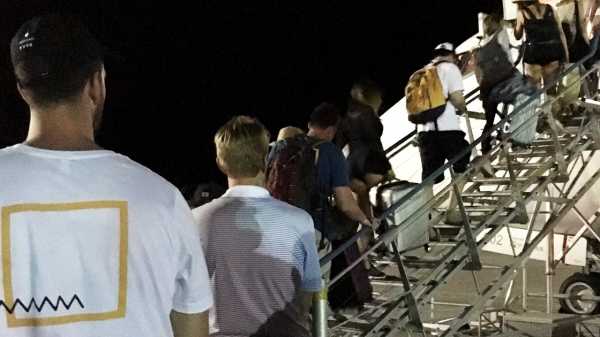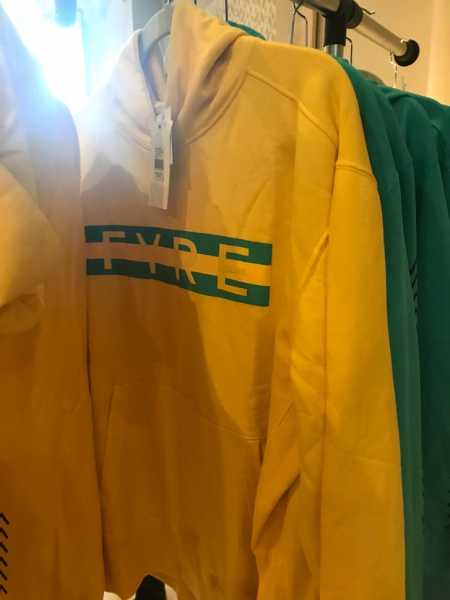
One evening earlier this week, I stepped into an unremarkable building, just north of Union Square, on my way to do something that I felt was equal parts stupid and funny. As a person who enjoys working a joke into the ground, I felt giddy with anticipation as I made my way up to the sixth floor. There, I would find a pop-up store full of dead-stock merchandise from last year’s Fyre Festival—one of the most beleaguered, and most memed, events in recent cultural memory.
Organized by the young entrepreneur Billy McFarland and the rapper Ja Rule, and promoted by Instagram-famous models like Kendall Jenner and Bella Hadid, the Fyre Festival was meant to be a once-in-a-lifetime experience for fun-loving, upwardly mobile millennials. Planned for two consecutive weekends, in late April and early May of last year, on the “private island” of Fyre Cay, in the Bahamas, the festival promised to be an upgraded Coachella, boasting musical performances by Blink-182 and Migos, fine dining, and luxury beachside villas, with “concierge packages” selling for as much as fifty thousand dollars. But a combination of professional ineptitude, Ponzi scheming, and, eventually, pure panic led to disaster. Attendees found themselves at a radically underprepared festival site, where they were stranded in darkness on a beach, fighting, “Lord of the Flies”-style, to secure cover under tents intended for disaster zones, with meagre sustenance and damp, insufficient bedding. There were no musical performances, no hot models, and, at least initially, no way to get back to the mainland. (McFarland recently pleaded guilty to two counts of wire fraud in connection with organizing the festival, and faces up to forty years of prison time, though he will likely serve eight to ten years.)
The conditions on the festival grounds were, of course, unfortunate for those who had paid hundreds, if not thousands, of dollars to attend what they thought would be a FOMO-inspiring bacchanalia. (At the time, my colleague Jia Tolentino spoke with an attendee, then still stranded at Exuma Airport, who provided a levelheaded account of the chaos.) For some, however, the event provided an irresistible punch line. Instead of filtered, Facetuned bikini selfies, we got sweaty stragglers at an airport shit show; instead of white-sand beaches, a trash-strewn campground; instead of a beautifully plated, Instagram-ready meal, slices of cheese and bread slapped into a Styrofoam box. For once, in our dark times, we had a relatively benign misfortune rather than an honest-to-God catastrophe.
Social media exploded with gleeful Schadenfreude. A popular, Twitter-born joke posited that Ja Rule was a secret Communist who engineered Fyre Festival in order to Robin Hood its rich attendees; equally popular were the much retweeted images of festival attendees’ luggage getting chucked out of a shipping container in the middle of the night. “The only thing keeping me together right now is the Fyre Festival,” I tweeted at the time.
The event and its aftermath seemed like a comeuppance for aspirational, hubristic posturing, and a ready-made opportunity for some Ideology Critique 101: here was, metaphorically and literally, the underside of our young-money-flaunting, social-media-envy-generating era. It was the beautiful portrait of Dorian Gray suddenly morphing into its true self—a rotting, ravaged bro.

Naomi Fry
The aesthetic of the Fyre pop-up shop landed midway between the luxury promised by the festival and the disaster-relief-camp scenario that it actually delivered. The nondescript loft was sparsely furnished in décor that brought to mind the lobby of a midlevel hotel in, say, downtown Philadelphia: chandeliers, cream linen sofas, oversized vases holding decorative branches of limp flora. E.D.M. music blasted at an ear-splitting volume. The original video teaser for Fyre Festival, touting its location as an island “once owned by Pablo Escobar,” screened on a loop on a back wall. “All these things that may seem big and impossible . . . are not,” the voice-over intoned, as Hadid and her fellow-models frolicked beside a private jet, on a yacht, on a Jet Ski, and while feeding a small pig. What a life! (“Fyre Cay” was, in fact, just an undeveloped area on the larger island of Great Exuma, where Escobar never owned property.) Lining the space were racks hung thinly with Fyre Fest items: hoodies, T-shirts, and sweatpants in yellow, turquoise, white, and black, adorned with the Fyre logo—a graphic rendering of what looked like ocean waves—and stamped with the dates of the festival that never was. Most of the clothing retailed for two hundred dollars, and there were also baseball caps (for fifty dollars) and a commemorative Fyre Fest coin (for a hundred.)
The man in charge of the pop-up identified himself only as Chris H., and refused to be audio- or video-recorded: “I don’t need the publicity.” He had, he told me, an investment fund, a consultancy company, and a nonprofit that builds houses in Bangladesh (“I live on an airplane, basically”), and he didn’t want his investors to associate him with Fyre Fest. He had come across the merchandise by chance, he explained. It was languishing in a storage unit with lapsed rental fees, and when the goods were auctioned off Chris and his partner bought them. Chris himself, it turned out, had planned to attend Fyre Festival—he had spent around four thousand dollars on eight tickets, and ended up stuck in Miami when flights to the event site ceased to operate. But he and his friends had the best time in a hotel in South Beach, he assured me. As we spoke, his diamond-encrusted Cartier Love bangle and Audemars Piguet watch caught the chandelier light. (The watch, he told me, “costs more than a car, probably.”)
Chris said that more than a thousand people had R.S.V.P.’d to the pop-up, but few of them were showing up. A young blond woman wearing a silver Rolex and ripped jeans, who said that she was a model from Ukraine, sat next to me on the couch, taking languid selfies, uninterested in the merchandise. A man in Bermuda shorts and a baseball cap called the goods “a piece of history,” but didn’t purchase anything. Two young men named Rob and Ben, who told me they “live a block away” and “work in finance,” were also Fyre Fest survivors who never got their money back (“We had fun in Miami with our friends, though”), and they rifled through the shirts, debating whether purchasing a funny memento, reminiscent of their lost weekend, was worth the steep price tag. (“I’ve already lost enough money,” Ben said.) For extended stretches of time, the space was almost completely devoid of shoppers.
Coming to the pop-up, I had suspected I would witness a prime example of the ways capitalism cannibalizes its own picked-over carcass—upselling the detritus of a famously failed luxury music festival, likely to jaded culture vultures like myself, who want their social critique with a side of laughs. This would have allowed me to beat the dead horse of Fyre Fest for a while longer (maybe I’d buy a hoodie and wear it for the gag?) and also confirm my suspicions about our collective complicity in the cycle of buying and selling. It gave me pause that there weren’t many takers for a meta-repurposing of the dregs of Fyre (or at least not at this price point). How would I make sense of the event now? What interpretive meaning could I extract from it? What content could I cobble together to make into an Instagram story? All that was left was chaos, with no tools of ironic consumption to tie everything up in a comforting bow. As I sat reflecting on the cream linen couch, “It Ain’t Me,” by Selena Gomez and the Norwegian d.j. Kygo, played over the sound system—“Who’s gonna walk you through the dark side of the morning? Who’s gonna help you when the sun won’t let you sleep?”—and I guessed that it was time to leave. I made my way back to the elevator, empty-handed.
Sourse: newyorker.com






